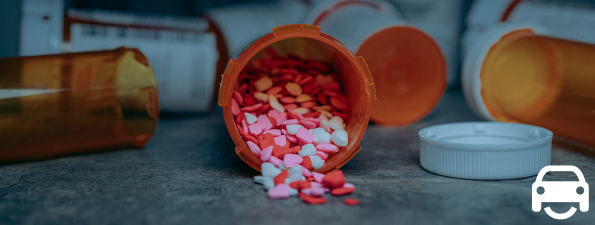Think You’re Safe to Drive? The Drug Driving Delusion

Drug-driving is increasing – and it kills. Between 2014 and 2022, the number of deceased drivers in fatal collisions with drugs detected increased by more than 70%. In 2023, 124 people died in crashes involving a drug-impaired driver. That’s 38% more than were killed the previous year. Drug driving is one of the fastest-growing threats on the roads but a lack of awareness of its dangers and the penalties if caught plus a lower level of social stigma attached to drug-driving compared with drink driving, means it’s happening without many of us realising.
What drugs are involved?
Class A, B and C drugs including, respectively, cocaine, ketamine and nitrous oxide although cannabis, a Class B drug, is the most used. It’s illegal to possess cannabis, never mind drive with a proscribed amount of it in your system. The psychoactive component in cannabis that is tested is called Delta-9-tetrahydrocannabinol, or THC for short. Each drug has a different legal limit. For THC it is 2 microgrammes per litre of blood but, for example, for cocaine, 10 microgrammes per litre of blood and for ketamine, 20 microgrammes per litre of blood.
How does cannabis affect driving?
Among its many side-effects, THC slows a driver’s reaction times, impairs their judgement, undermines their coordination so they don’t use the car’s controls effectively, and distorts their perception of time and distance. The severity of these symptoms depends on how much cannabis has been consumed but regardless, the effects of the drug last far longer than alcohol. With the legal limit being so low, the drug’s ability to linger in the system, and so for users to feel that after a few hours they must no longer be a risk, is why many of them take to the road believing they are not only capable of driving but also legally permitted to. Meanwhile, other users frequently micro-dose, believing they, too, are safe and legal to drive.
Given that drug limits are so low, how do the police spot a drug driver?
There is a clear link between road traffic offences and drug users with many drug drivers being identified because of moving traffic offences including vehicle defects, mobile phone use, not wearing a seatbelt and speeding. Others may have been involved in collisions or be driving erratically. However, the police don’t need a reason to stop a driver and so will conduct occasional roadside stops of every passing car, often at peak times in the day, when they might detect drugs or alcohol in the vehicle or on the driver’s breath.
How do the police test for drugs?
One method is a simple impairment test where the driver is instructed to perform simple movements that can reveal a lack of coordination, resulting in their arrest. Another is a saliva test at the roadside, although this can detect only cannabis and cocaine. It takes around eight minutes to process.
What if the saliva test records a positive?
The driver is arrested and taken to a police station for a more accurate and comprehensive blood test that detects drugs including ecstasy, LSD, ketamine and heroin. However, it can take up to five months for the results to be known, during which time the offender could get back behind the wheel.
What are the penalties for drug driving?
A minimum 12-month driving ban, a criminal record, an unlimited fine, albeit linked to the drivers’ income, and up to six months in prison. The penalty for causing death by dangerous driving under the influence of drugs is a maximum prison sentence of 14 years.
How successfully are the police tackling drug driving?
They would argue it’s a battle we’re all responsible for fighting, not least by being prepared to call out users who do it. However, testing for drugs is now a part of the police’s traditional, four-week Christmas drink-drive campaign that it calls Operation Limit. Last Christmas police stopped 74,456 vehicles and carried out 7,727 drug tests, resulting in 42.2% of motorists testing positive for drugs. In contrast, 50,948 breath tests for alcohol were carried out, resulting in 9.7% of motorists either testing positive for alcohol or refusing to take the test. A total of 1,065 field impairment tests were carried out.
What challenges does drug driving enforcement face?
The blood test for drugs can take up to five months to process but the statutory time limit for a hearing at a Magistrate’s Court is six months from arrest. This delay means some drug drivers are getting away with nothing more than a telling off and is leading some forces to focus on other driving offences such as drink driving instead. The blood test is also very expensive. The National Police Chiefs’ Council (NPCC) says the cost of drug driving enforcement ‘represents a significant challenge’.
Is driving while on prescription drugs dangerous?
It is illegal for a motorist to drive after taking prescribed drugs if it impairs their driving. Prescribed medication includes amphetamines, clonazepam, diazepam, flunitrazepam, lorazepam, methadone, morphine, oxazepam, and temazepam. In 2023, investigators found that a woman who killed another driver in a head-on crash was impaired by prescription drugs. Kelly Cox (35) was jailed for nearly three years and disqualified from driving on her release.
What is the public’s view of drug driving?
According to research carried out by IAM RoadSmart, more than a fifth of motorists (22%) aged 17-34 believe it is fine to drive after using Class A drugs, while 13% of drivers of all ages consider it to be acceptable. Meanwhile, the survey found that 30% of drivers think driving after taking prescription drugs represented little or no threat to their safety. William Porter, IAM RoadSmart Policy, Public Affairs and Communications Manager, said, “Social acceptability of drink-driving took generations to change and we must be clear that we will be as intolerant of drug-drivers as we are drink-drivers.”





